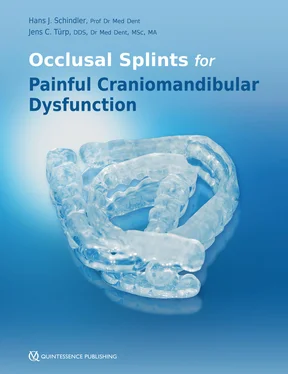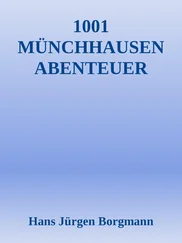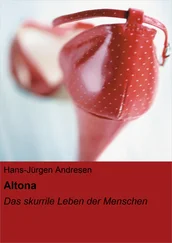Occlusal Splints for Painful Craniomandibular Dysfunction
Occlusal Splints for Painful Craniomandibular Dysfunction
Hans Jürgen Schindler, Prof Dr Med Dent
Professor
Department of Prosthodontics
University of Würzburg
Würzburg, Germany
Jens Christoph Türp, DDS, Dr Med Dent, MSC, MA
Professor
Department of Oral Health and Medicine
University of Basel
Basel, Switzerland
With contributions from
Lydia Eberhard, Nikolaos Nikitas Giannakopoulos, Daniel Hellmann, Alfons Hugger, Bernd Kordaß, Martin Lotze, and Marc Schmitter

First published as Konzept Okklusionsschiene: Basistherapie bei schmerzhaften kraniomandibulären
Dysfunktionen in 2017 by Quintessenz Verlags-GmbH, Berlin, Germany.
Library of Congress Cataloging-in-Publication Data
Names: Schindler, Hans Jürgen, author. | Türp, Jens Christoph, author.
Title: Occlusal splints for painful craniomandibular dysfunction / Hans Jürgen Schindler, Jens Christoph Türp.
Other titles: Konzept Okklusionsschiene. English
Description: Batavia, IL : Quintessence Publishing Co, Inc, 2021. | Includes bibliographical references and index. | Summary: “This book offers readers with a professional interest a clear guide to help them address the issue of temporomandibular disorders in theory and practice and provide their TMD patients with the best possible treatment”-- Provided by publisher.
Identifiers: LCCN 2020008037 | ISBN 9780867157956 (hardcover)
Subjects: MESH: Craniomandibular Disorders--therapy | Occlusal Splints | Facial Pain--therapy
Classification: LCC RK523 | NLM WU 140.5 | DDC 617.6/43--dc23
LC record available at https://lccn.loc.gov/2020008037
A CIP record for this book is available from the British Library.
ISBN: 978086757956

©2022 Quintessence Publishing Co, Inc
Quintessence Publishing Co, Inc
411 N Raddant Road
Batavia, IL 60510
www.quintpub.com
5 4 3 2 1
All rights reserved. This book or any part thereof may not be reproduced, stored in a retrieval system, or transmitted in any form or by any means, electronic, mechanical, photocopying, or otherwise, without prior written permission of the publisher.
Editor: Lori Bateman
Design: Sue Zubek
Production: Angela Kreeger and Sue Robinson
Printed in Croatia
Contents
Foreword
Preface
Contributors
Part A Practice of Occlusal Splint Therapy and Coordinative Training
1INTRODUCTION
Jens C. Türp
Craniomandibular Dysfunction
2STRUCTURED TREATMENT APPROACH IN PRACTICE
Hans J. Schindler
Diagnostics
Treatment of Painful CMD
Typical Painful CMD Case Studies: From History Taking to Treatment
3INTEROCCLUSAL REGISTRATION IN SPLINT THERAPY
Daniel Hellmann, Jens C. Türp
Method of Closing Movement onto a Frontal Plateau
4SPLINT FABRICATION
Daniel Hellmann
Model Fabrication
Model Mounting
Modular Rehabilitation Splint System
MRS Basic Splint (MRS 0)
Modular Modification of the MRS 0
Fabrication of an Efficient MRS 1 (Michigan Concept) Using CAD/CAM
5COORDINATIVE TRAINING FOR FUNCTIONAL REHABILITATION
Daniel Hellmann
Pain and Motor Adaptation
Pain Adaptation and Rehabilitation
Rehabilitation of the Craniomandibular System
Practice of Coordinative Training in Functional Rehabilitation
Case Study
Indication for Coordinative Training and Monitoring Outcome
Part B Aspects of Painful CMD and Splint Therapy Explored in Depth
6RISKS
Jens C. Türp, Hans J. Schindler, Alfons Hugger, Marc Schmitter
Definition of Risk
Jens C. Türp
Definition, Calculation, and Interpretation of Odds Ratio
Jens C. Türp
Myoarthropathies of the Masticatory System
Jens C. Türp
Occlusion and CMD
Jens C. Türp
TMJ Compression and Distraction
Jens C. Türp, Hans J. Schindler, Alfons Hugger
Bruxism
Marc Schmitter
7DIAGNOSTICS
Lydia Eberhard, Nikolaos Nikitas Giannakopoulos, Hans J. Schindler
Staged Model of CMD Diagnostics
Hans J. Schindler
Differential Diagnoses
Hans J. Schindler
Criticism of Classic Taxonomies
Nikolaos N. Giannakopoulos
Quantitative Sensory Testing and Its Practical Relevance
Lydia Eberhard
Criticism of Samples Included in Treatment Studies
Nikolaos N. Giannakopoulos
8TREATMENT
Hans J. Schindler, Alfons Hugger
Effectiveness of Treatment Options for Painful CMD
Possible Mechanisms of Physiotherapy in Painful CMD
Treatment Results from Dental Practices
Rehabilitation in Functional Therapy
Alfons Hugger
9NEUROBIOLOGIC BACKGROUND OF OCCLUSAL SPLINT THERAPY
Hans J. Schindler
Muscle Physiology
Temporomandibular Joints
Jaw Muscle Pains
TMJ Pains
Explanatory Models of Chronification of Pain
Motor Adaptation to Pain
Muscle Regeneration Potential
10NEUROBIOLOGY AND BIOMECHANICS OF OCCLUSAL SPLINT THERAPY
Hans J. Schindler
Traditional Hypotheses
Current Hypotheses
Pathophysiologic Effects of Postural Changes: Is Occlusal Splint Therapy a Cross-Segmental Treatment Modality?
11CEREBRAL REPRESENTATION OF OCCLUSAL SPLINT THERAPY: FUNCTIONAL MRI STUDIES
Martin Lotze, Bernd Kordaß, Hans J. Schindler
Cerebral Representation of Neuromuscular Activity
Modification of Cerebral Activation Patterns by Occlusal Splint Therapy
Cerebral Activation Patterns and Pain
INDEX
Foreword
It is a great challenge for any teacher to write a book with the aim of presenting the theory and practice of a particular dental clinical specialty. To accomplish this task successfully requires extensive clinical experience and excellent knowledge of the scientific principles underlying the specialty. Writers engaging in such an endeavor—like the authors of this book—usually have a clear goal in mind: to improve dental health care, which means making innovations in diagnostics and treatment accessible to dental practitioners.
Achieving this goal is a particular challenge given the subject of this book. Therapy for painful craniomandibular dysfunction (CMD) is a field of dentistry that undoubtedly differs greatly from traditional subjects in dental medicine, such as periodontics, restorative dentistry, or oral surgery. In these subject areas, innovation essentially means adapting clinical procedures to new technologies, such as the use of digital resources. The objective of adaptive processes has hardly changed in the past 100 years: to enhance the mechanical perfection of treatment methods while simultaneously increasing the efficiency and safety of the working materials being used. Generations of dentists in education, research, and practice have pursued this objective—in some cases with great success. This was accompanied by a concentration on the results of mechanical working procedures. Every step toward perfection was regarded as clinical progress. Michael Heners coined the term “technomorphic model of dentistry” for this orientation of dental medicine. Based on this model, the mechanically defined actions of the clinician determine the quality of the dental therapy provided. Accordingly, better dental care can only be achieved by optimizing the dental intervention in terms of technique.
Читать дальше














